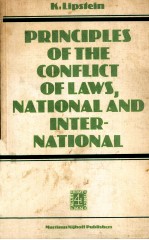

Principles of the conflict of laws national and internationalPDF电子书下载
- 电子书积分:8 积分如何计算积分?
- 作 者:by K. Lipstein.
- 出 版 社:M. Nijhoff ;Distributors for the U.S. Kluwer Boston
- 出版年份:1981
- ISBN:9024725445
- 页数:143 页
Part Ⅰ. The nature and function of Private International Law 1
Section 1. Introduction 1
Section 2. Rome and beyond 3
Section 3. The period after the division of the Roman Empire—personality of laws 3
Section 4. Feudalism and the revival of Roman Law 4
Section 5. Feudalism 4
Section 6. Italy—the Legists 5
Section 7. The doctrine of the Statutists 7
Section 8. The French school in the 16th Century—Dumoulin and D'Argentre 12
Section 9. The Dutch school—Comity 13
Section 10. The subsequent development of the doctrine of Huber—England 17
Section 11. The United States 19
Section 12. Modern Private International Law—Wachter, Savigny 20
Section 13. Modern doctrines of territoriality or pseudo-territoriality—acquired rights 23
Section 14. Sociological neo-statutists 28
Section15. Wachter redivivus—Ehrenzweig 30
Section16. Conflict of laws and the American Constitution 32
Section 17. Governmental interests as conflict resolving factors—Currie—Neo-statutists 36
Section18. "Result selecting" principles—Cavers 39
Section19. The international use of the new doctrines 41
Section 20. Conclusions 44
Notes to part Ⅰ 46
Part Ⅱ. The relationship between Public and Private International Law 63
Section 21. The influence of Public International Law upon domestic Private International Law 63
Section 22. Private International Law as part of Public International Law—choice of law before international tribunals 67
Section 23. Recognition and the application of foreign law 74
Section 24. Scrutiny of, and refusal to apply, the law and to respect the executive acts of a foreign recognized government 77
Section 25. Conclusions 80
Notes to part Ⅱ 81
Part Ⅲ. The structure and interpretation of rules of Private International Law 93
Section 26. Structure 93
Section 27. Interpretation 94
Section 28. Spatially conditioned internal rules 99
Section 29. Transposition, substitution and adaptation 102
Section 30. Renvoi 104
Section 31. Preliminary question 107
Section 32. Conflict of laws in time 113
Notes to part Ⅲ 115
Part Ⅳ. Conclusions 125
Bibliography 127
Table of cases 129
Index 139
- 《日本庭园 简约 宁静 和谐》(美)吉塔·K.梅塔,(日)多田君枝 2019
- 《极简主义 小房间住出大空间》(美)丹娜·K.怀特 2020
- 《哈利·波特与魔法石 第1部分》(英)J. K.罗琳(J. K. Rowling)著 2019
- 《心理学经典入门 第3版》(美)桑德拉·K.切卡莱丽,(美)J.诺兰 2020
- 《Foundations of criminal law》[edited] by Leo Katz 1999
- 《哈利·波特与魔法石 第2部分》(英)J. K.罗琳(J. K. Rowling)著 2019
- 《哈利·波特与密室 第1部分》(英)J. K.罗琳(J. K. Rowling)著 2019
- 《漫画半坡 英文版》Edited by Xian Banpo Museum 2015
- 《Law:its origin growth and function》by James Coolidge Carter 1907
- 《流动非线性及其同伦分析 流体力学和传热》(美)瓦捷拉维鲁(VAJRAVELU K.),(美)隔德(GORDER R.A.V)著 2012
- 《青少年管乐队训练曲集 基础 1 F调圆号》段颖译;(美)约翰·埃德蒙森,(美)安妮·麦金蒂 2019
- 《心血管病实践 评估和治疗》(美)巴里戈,(美)伊戈尔原著;王增武,王丛妙,王建昌主译 2013
- 《WPS最新版本 6.0F 源代码剖析》莫文,卓强,柯龙编 1993
- 《价格谈判》(美)汤姆·赖利(TomReilly)著 2013
- 《非常时装 F》顾华明主编 1999
- 《网络学习行为分析及建模》彭文辉著 2013
- 《寡头政治 帝国日本的制度选择》(美)J.马克·拉姆塞耶(J.MarkRamseyer),(美)弗朗西丝·M.罗森布鲁斯(FrancesMcCallRosenbluth)著 2013
- 《医学英语时文阅读 第2册》顾萍主编 2014
- 《连接者 社交网络中的商业先锋》玛丽贝丝·库兹梅斯基 (Maribeth Kuzmeski)著;明爱译 2014
- 《成功英语阅读策略 F级 上(适用于高中三年级)》(美)Diane Lapp James Flood著;中方主编 2004
